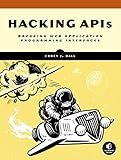Best Tools for GraphQL API Security to Buy in November 2025

GraphQL Best Practices: Gain hands-on experience with schema design, security, and error handling



Hacking APIs: Breaking Web Application Programming Interfaces



Mastering Spring Boot: From Basics to Advanced Concepts - A Practical Guide for Java Developers


Securing a GraphQL API involves implementing various measures to protect the API from unauthorized access, data breaches, and other security threats. Here are some important aspects to consider:
- Authentication: Ensure that all requests to the API are authenticated. Implement a suitable authentication mechanism, such as JSON Web Tokens (JWT), OAuth, or API keys to validate the identity of the requester.
- Authorization: Once authenticated, apply authorization rules to limit access to specific resources or actions based on the user's role, permissions, or other criteria. Implement a role-based access control (RBAC) mechanism or custom authorization logic accordingly.
- Input Validation: Validate and sanitize user input to prevent injection attacks, such as SQL injection or NoSQL injection. Ensure that your GraphQL server employs proper input validation techniques to avoid any security vulnerabilities.
- Rate Limiting: Implement rate limiting to prevent abuse, brute force attacks, or DDoS attacks. Limit the number of requests processed per unit of time from individual clients or IP addresses.
- Secure Communication: Use HTTPS/TLS to encrypt the communication between the client and the server. This ensures that intercepted network traffic cannot be easily read or modified by attackers.
- Protect Sensitive Data: Avoid returning sensitive information in the API responses, especially if it is not required by clients. Encrypt sensitive data at rest and in transit where necessary.
- Handle Errors Safely: Handle errors gracefully without exposing sensitive information or underlying system details. Always provide minimal error information to clients while logging detailed error messages for developers.
- Secure Dependencies: Ensure that all third-party libraries, frameworks, and tools used in your GraphQL implementation are regularly updated and do not have known security vulnerabilities.
- Implement Monitoring and Logging: Implement comprehensive logging and monitoring systems to keep track of API activities, detect suspicious behavior, and respond promptly to any security incidents.
- Regularly Conduct Security Audits: Perform regular security audits and vulnerability assessments to identify and remediate any potential weaknesses or vulnerabilities in your GraphQL API.
It is important to note that securing a GraphQL API requires a holistic approach and may vary depending on your specific use case and requirements.
What is the difference between authentication and authorization in the context of securing a GraphQL API?
Authentication and authorization are two important aspects of securing a GraphQL API, and they serve different purposes.
Authentication is the process of verifying the identity of a user or client device attempting to access a system or resource. It ensures that the user is who they claim to be. It typically involves providing credentials (such as a username and password) or using mechanisms like tokens, keys, or certificates to validate the user's identity. Once authenticated, the user is given a unique identifier (e.g., access token) that proves their identity during subsequent requests.
Authorization, on the other hand, is the process of granting or denying access to specific resources or operations based on the authenticated user's permissions or privileges. Once the user is authenticated, authorization determines whether the user is allowed to perform certain actions or access particular data. It typically involves defining roles, permissions, or access control rules that govern what a user can or cannot do within the system.
In the context of securing a GraphQL API, authentication is used to verify the identity of the client making the request. It ensures that the client has the necessary credentials or access token to prove their identity. Authorization, on the other hand, is used to determine whether the authenticated client has the necessary permissions to perform the requested GraphQL operations.
For example, suppose a GraphQL API has multiple types of users (e.g., regular users and administrators). Authentication would ensure that a user is who they claim to be by validating their credentials or access token. Authorization would then determine what actions or data the authenticated user is allowed to access. An administrator might have permission to perform all types of operations, while a regular user may only have access to certain data or actions.
In summary, authentication verifies the identity of a user, while authorization determines what actions or data that authenticated user is allowed to access. Both are essential components of securing a GraphQL API.
What is content sniffing and how can it impact the security of a GraphQL API?
Content sniffing, also known as MIME sniffing, is a technique used by web browsers to try to determine the type of content being served by a web server, based on the headers and structure of the response. It is primarily intended to handle cases where the Content-Type header is incorrect or missing.
However, content sniffing can introduce security risks when it comes to GraphQL APIs. The main issue arises from the fact that GraphQL APIs interpret all incoming requests as GraphQL queries or mutations, regardless of the Content-Type header specified by the client.
For example, if a malicious user sends a request with a Content-Type header indicating an image or other binary file type, but the body of the request contains GraphQL syntax, some browsers may ignore the specified Content-Type and attempt to parse the content as JavaScript. This can lead to potential security vulnerabilities, such as remote code execution, cross-site scripting (XSS), or other attack vectors.
To mitigate the security impact of content sniffing, it is crucial to:
- Strictly define and enforce the Content-Type header for GraphQL API requests. This ensures that the server and client always expect valid GraphQL syntax in the request body, preventing any unintended parsing behaviors.
- Implement input validation and sanitization on the server-side to ensure that GraphQL queries and mutations are safe from malicious content or code injection.
- Enable secure HTTP headers like Content-Security-Policy (CSP) to restrict the execution of scripts or content from unrecognized sources, reducing the scope for potential attacks.
By taking these precautions, the security risks associated with content sniffing can be effectively minimized, enhancing the overall security of a GraphQL API.
How to secure a GraphQL API?
Securing a GraphQL API involves implementing various security measures to protect the API and its data. Here are some steps to help you secure your GraphQL API:
- Authentication: Implement a proper authentication mechanism to verify the identity of clients accessing the API. Use techniques like JWT (JSON Web Tokens) or OAuth2 to authenticate and authorize each request.
- Authorization: Define fine-grained access control rules based on user roles and permissions. Authorize each GraphQL resolver function to ensure that clients have the appropriate permissions to execute specific queries, mutations, or subscriptions.
- Input validation: Validate and sanitize user input to prevent common security vulnerabilities like SQL injection or cross-site scripting (XSS) attacks. Use libraries like Joi or Yup for input validation.
- Rate limiting: Implement rate limiting to mitigate the risk of abuse or denial-of-service attacks. Enforce restrictions on the number of requests a client can make within a specific timeframe.
- Error handling: Implement proper error handling and avoid leaking sensitive information in error responses. Return generic error messages to clients while logging detailed errors on the server side.
- Secure transport layer: Use HTTPS (TLS/SSL) to encrypt data sent over the network between the client and the API server. This prevents eavesdropping, tampering, or man-in-the-middle attacks.
- Limit introspection: Disable or limit GraphQL introspection queries in production environments. Introspection can provide valuable information to attackers, including the structure and schema of your API.
- Content security policies: Implement content security policies (CSP) to restrict the types of content that can be loaded by the client. This prevents malicious scripts or resources from being executed on the client-side.
- Monitor and log: Implement comprehensive monitoring and logging mechanisms to detect and respond to any suspicious or malicious activity. Monitor logs regularly and set up alerts for any anomalies or security-related events.
- Keep dependencies up to date: Regularly update and patch your GraphQL server, as well as any third-party dependencies, frameworks, or libraries used in your API. Keeping them up to date helps ensure that known security vulnerabilities are addressed.
Remember, security is an ongoing process, and it's important to stay updated with the latest security practices and apply them to your GraphQL API.
How to handle and sanitize user input to prevent injection attacks in a GraphQL API?
To prevent injection attacks in a GraphQL API, you can follow these steps to handle and sanitize user input effectively:
- Use a Validated Schema: Define a schema for your GraphQL API using a tool like GraphQLSDL or GraphQL Nexus. Make sure to validate and sanitize all input fields against the defined schema.
- Input Validation: Validate user inputs against specific rules and constraints defined in your schema. Check for data type, length, format, and any custom validation rules. Reject or sanitize any input that fails validation.
- Use Prepared Statements or Parameterized Queries: When interacting with a database, use prepared statements or parameterized queries instead of concatenating user input directly into SQL queries. This will help prevent SQL injection attacks.
- Input Sanitization: Sanitize user inputs to remove any potentially malicious or unsafe characters. This can be done by utilizing a sanitization library or writing custom sanitization code specific to your needs.
- Use ORM or Query Builders: If using an Object-Relational Mapping (ORM) tool or query builder library, use their methods for safe querying rather than building queries manually. These tools often handle parameterization and sanitization of input.
- Implement Rate Limiting: Protect your GraphQL API with rate limiting mechanisms to prevent abuse and limit the impact of any potential attacks.
- Avoid using eval or Function constructors: Avoid using functions like eval or Function constructors that can execute arbitrary code from user input. These functions can introduce security vulnerabilities.
- CORS Configuration: Implement proper Cross-Origin Resource Sharing (CORS) configuration to prevent unauthorized cross-origin requests that could exploit your API.
- Regularly Update Dependencies: Keep all your dependencies up to date, including the GraphQL library, database drivers, and any sanitization or validation libraries, to ensure you have the latest security patches.
- Input Whitelisting: Consider implementing input whitelisting where you define a list of allowed values for specific input parameters. Any input outside the defined whitelist should be rejected or sanitized.
Remember, while these steps can help mitigate injection attacks, it's essential to stay informed about the latest security best practices and regularly review and update your code to protect against new threats.
